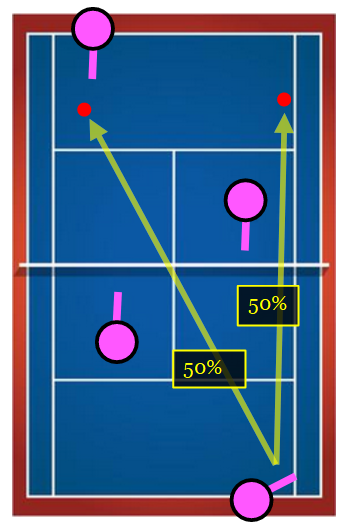One of the most common situations in which players adopt a suboptimal mixed strategy is doubles return of serve.
In many matches, no, you don’t have to hit your serve returns down the line. Ever. Stop wasting equity on that low percentage shot (until you’re forced to).
A quick note before we move on – I’m not talking about the case when your opponent is so bad at volleying that they miss everything. If that’s the case, high percentage returns up the line are great. (Note, though, that in this case your are not trying to hit it past them; you’re just trying to give them a volley so that they miss). At the 3.5 level, this isn’t actually that uncommon, so understand that the following discussion isn’t about that situation.
I’m referencing match conditions with a volleyer who is competent – they will routinely put away easy volleys, and they’ll keep the rallies neutral on tougher volleys.
Alright, back to not overdoing it with the down the line return.
The Down the Line Return is Hard to Execute
The down the line return has THREE factors working against it, making it a difficult shot to execute.
You are:
- Aiming to a small target
- Hitting over the highest part of the net
- Changing the direction of the ball
Notice that a shot like the gold standard of high percentage shots – the cross-court forehand out of the forehand corner – has none of these attributes. On that shot, we’re aiming to a large target, over the lowest part of the net, and simply flipping the ball’s direction. The down the line return is the opposite.
Any one of these three aggravating factors on their own should give you pause when selecting a shot, especially with high frequency. All three together? That’s a recipe for a lot of misses.
Only Mix In Second Best Shots When Forced To
I get it – in doubles, the cross-court shot is far less effective than in singles. The net player can poach the cross-court shot and hit a winner of off it FAR more consistently than a player standing at the baseline ever could. But remember, just because it’s possible that your high percentage cross-court return will get volleyed doesn’t mean that it will.
This possibility alone is not enough that you should now be trying hit to a small target, over the highest part of the net, while changing the direction of the ball in the process. Make the net player prove to you, by aggressively and consistently poaching, that returning cross-court is not always your highest equity option.
Don’t Deviate Too Quickly

If the net player has hit 6 volley winners on your returns in the last few games, then I get it, you’re going to have to throw some returns up the line. But if you’re going to start aiming to that low percentage target, you’d better make sure it’s worth it.
I’ve seen players who hit down the line on roughly 50% of their returns, and of those make only about 50% in (much less win the point on them), meanwhile the net player has successfully poached zero times in the entire match.
Do not abandon the cross-court return, your highest equity shot before adjustment, until proven otherwise. If you hit a solid, deep cross-court return and it isn’t poached, do it again. And do it again, and again.
Even after your opponent poaches once, do it again. Is that poach repeatable? Maybe on the next poach, the net player misses, because his volleys aren’t amazing (which is why he wasn’t poaching often in the first place). Before adding in the worse-in-a-vacuum down the line return, ensure that doing so actually increases your overall win rate. In many cases, it won’t.
If it Ain’t Broke, Don’t Fix It
Tennis is about winning points. If one pattern is winning you 9 out of every 10 points, then it doesn’t matter if your opponent knows it’s coming. There is no reason to “keep’m honest” if you’re winning almost every time. Just keep repeating the same thing, and keep winning.
Mixed strategies are necessary to prevent yourself from being exploited when your opponent is adjusting in real time. Very often, though, they either won’t adjust, or they simply won’t have an effective adjustment to go to, even if they wanted to. In these cases, don’t waste equity by playing a mixed strategy, using second best shots at some frequency.
Instead, just hammer your best option over, and over, and over again, and watch the points roll in.




